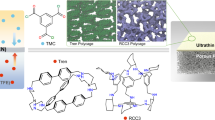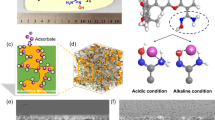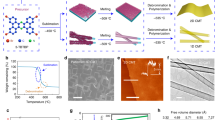Abstract
We describe a novel “tentacle-type” porous membrane that allows adsorption of enzymes in multilayers in amounts about 50-fold those permitted by monolayer adsorption. A diethylamino (DEA) group as an anion-exchanger was appended to a polymer chain, grafted onto the pores of a hollow-fiber membrane. A urease solution was forced to permeate through the pores of the anion-exchange membrane, which had a DEA group density up to 2.9 mmol per gram of membrane and a thickness of 0.8 mm. The grafted chain with a higher DEA group density provided a larger number of three-dimensional adsorption (tentacle-like binding) sites for urease. The binding capacity exceeded one gram of urease per gram of the membrane at DEA group densities higher than 1.6 mmol per gram, which amounted to a more than 37-fold greater amount of adsorbed enzyme compared to monolayer adsorption. In addition, urease captured by the DEA on the graft chain could be quantitatively eluted with retention of 90% of the feed urease activity.
This is a preview of subscription content, access via your institution
Access options
Subscribe to this journal
Receive 12 print issues and online access
$209.00 per year
only $17.42 per issue
Buy this article
- Purchase on Springer Link
- Instant access to full article PDF
Prices may be subject to local taxes which are calculated during checkout
Similar content being viewed by others
References
Brandt, S., Goffe, R.A., Kessler, S.B., O'Connor, J.L. and Zale, S.E. 1988. Membrane-based affinity technology for commercial scale purifications. Bio/Technology 6: 779–782.
Tennikova, T.B., Bleha, M., Svec, F., Almazova, T.V. and Belenkii, B. G. 1991. High-performance membrane chromatography of proteins. A novel method of protein separation. J. Chromatogr. 555: 97–107.
Josic, D., Reusch, J., Loster, K., Baum, O. and Reutter, W. High-performance membrane chromatography of serum and plasma membrane proteins. 1992. J. Chromatogr. 590: 59–76.
Shinano, H., Tsuneda, S., Saito, K., Furusaki, S. and Sugo, T. 1993. Ion exchange of lysozyme during permeation across a microporous sulfopropyl-group-containing hollow fiber. Biotechnol. Prog. 9: 193–198.
Champluvier, B. and Kula, M.-R. 1991. Microfiltration membranes as pseudo-affinity adsorbents: modification and comparison with gel beads. J. Chromatogr. 539: 315–325.
Iwata, H., Saito, K., Furusaki, S., Sugo, T. and Okamoto, J. 1991. Adsorption characteristics of an immobilized metal affinity membrane. Biotechnol. Prog. 7: 412–418.
Kim, M., Saito, K., Furusaki, S., Sato, T., Sugo, T. and Ishigaki, I. 1991. Adsorption and elution of bovine γ-globulin using an affinity membrane containing hydrophobic amino acids as ligands. J. Chromatogr. 585: 45–51.
Serafica, G.C., Pimbley, J. and Belfort, G. 1994. Protein fractionation using fast flow immobilized metal chelate affinity membranes. Biotech. Bioeng. 43: 21–36.
Kugel, K., Moseley, A., Harding, G.B. and Klein, E. 1992. Microporous poly(caprolactam) hollow fibers for therapeutic affinity adsorption. J. Membr. Sci. 74: 115–129.
Langlotz, P. and Kroner, K.H. 1992. Surface-modified membranes as a matrix for protein purification. J. Chromatogr. 591: 107–113.
Nachaman, M., Azad, A.R.M. and Bailon, P. 1992. Membrane-based receptor affinity chromatography. J. Chromatogr. 597: 155–166.
Muller, W. 1990. New ion exchangers for the chromatography of biopolymers. J. Chromatogr. 510: 133–140.
Tsuneda, S., Shinano, H., Saito, K., Furusaki, S. and Sugo, T. 1994. Binding of lysozyme onto a cation-exchange microporous membrane containing tentacle-type grafted polymer branches. Biotechnol. Prog. 10: 76–81.
Tsuneda, S., Saito, K., Furusaki, S. and Sugo, T. 1995. High-throughput processing of proteins using a porous and tentacle anion-exchange membrane. J. Chromatogr. 689: 211–218.
Yamagishi, H., Saito, K., Furusaki, S., Sugo, T., Hosoi, F. and Okamoto, J. 1993. Molecular weight distribution of methyl methacrylate grafted onto a microfiltration membrane by radiation-induced graft polymerization. J. Membr. Sci. 85: 71–80.
Tsuneda, S., Saito, K., Furusaki, S., Sugo, T. and Ishigaki, I. 1992. Water/acetone permeability of porous hollow-fiber membrane containing diethylamino groups on the grafted polymer branches. J. Membr. Sci. 71: 1–12.
Kim, M., Kojima, J., Saito, K., Furusaki, S. and Sugo, T. 1994. Reduction of nonselective adsorption of proteins by hydrophilization of microfiltration membranes by radiation-induced grafting. Biotechnol. Prog. 10: 114–120.
Sumner, J.B. and Hand, D.B. 1929. The isoelectric point of crystalline urease. J. Am. Chem. Soc. 31: 1255–1260.
Searcy, R.L., Foreman, J.A., Ketz, A. and Reardon, J. 1967. A new automated method for urea nitrogen analysis. Am. J. Clin. Path. 47: 677–681.
Horiike, K., Tojd, H., Yamano, T. and Nozaki, M. 1983. Interpretation of the stokes radius of macromolecules determined by gel filtration chromatography. J. Biochem. 93: 99–106.
Author information
Authors and Affiliations
Rights and permissions
About this article
Cite this article
Matoba, S., Tsuneda, S., Saito, K. et al. Highly Efficient Enzyme Recovery Using a Porous Membrane with Immobilized Tentacle Polymer Chains. Nat Biotechnol 13, 795–797 (1995). https://doi.org/10.1038/nbt0895-795
Received:
Accepted:
Issue Date:
DOI: https://doi.org/10.1038/nbt0895-795
This article is cited by
-
Adsorption of bovine serum albumin to a polymer brush prepared by atom-transfer radical polymerization in a porous inorganic membrane
Journal of Porous Materials (2007)
-
Selective binding of docosahexaenoic acid ethyl ester to a silver‐ion‐loaded porous hollow‐fiber membrane
Journal of the American Oil Chemists' Society (1999)



